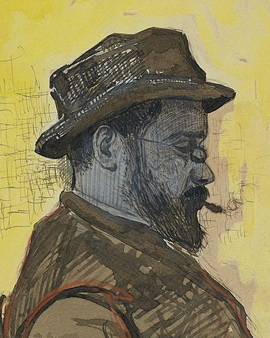Maximilien Luce was a French post-impressionist. His main motif was the everyday life and work of the simple Parisian population. Luce was born in Montparnasse in 1858 and also came from the working class. The memories of his childhood environment had a lasting influence on the work of the talented Frenchman. Luce's personal style was characterized by his dotted brushstrokes and well-matched color harmonies.
After his first apprenticeship with the wood engraver Henri Theophile Hildebrand, Luce began working in the studio of the wood engraver Eugene Froment. There the young man worked as a diligent assistant creating illustrations for various French and foreign magazines such as "The Graphic".
On the side, Luce sporadically attended art courses at the Academie Suisse in order to realize his dream of becoming a free artist. The artist Carolus-Duran also gave artistic instruction to the ambitious young man. After his acquaintance with the painters Leo Gausson and Emile-Gustave Peduzzi, Luce began to paint landscapes. Accompanied by his new friends, who were gifted open-air painters, Luce moved to the fields and meadows of France and produced much and eagerly. In 1887 the talented young artist had his first success at a group exhibition in the Salon des Artistes Independents in Paris. Luce's painting attracted the attention of Camille Pissarro. The renowned art critic Felix Feneon was highly enthusiastic about the new discovery of the French art world. Paul Signac finally acquired the painting and thus established the starting point of his artistic career.
Luces success grew steadily and he exhibited his oil paintings every year with the Neo-Impressionists. Together with his friends and artist colleagues he travelled to London, Saint-Tropez, Belgium and Brittany. One of his favorite motifs, however, remained the river promenade of the Seine west of Paris.
In contrast to other Impressionists, Luce preferred urban motifs such as the lively street life in the Latin Quarter, the construction workers on the boulevards of Paris and the wide view over the roofs of Montmartre, in addition to depictions of nature.
Maximilien Luce was considered a master of his profession. His works are still very popular today. The multifaceted artist created a considerable oeuvre of watercolours, lithographs, oil paintings and illustrations.
×





.jpg)
.jpg)
.jpg)
.jpg)
.jpg)
.jpg)
.jpg)
.jpg)
.jpg)
.jpg)
.jpg)
.jpg)
.jpg)
.jpg)
.jpg)
.jpg)
.jpg)
.jpg)
.jpg)
.jpg)
_-_(MeisterDrucke-1658222).jpg)
_-_(MeisterDrucke-1658222).jpg)
.jpg)
.jpg)
.jpg)
.jpg)
.jpg)
.jpg)
.jpg)
.jpg)
.jpg)
.jpg)
.jpg)
.jpg)
.jpg)
.jpg)
.jpg)
.jpg)
.jpg)
.jpg)
_-_(MeisterDrucke-1658460).jpg)
_-_(MeisterDrucke-1658460).jpg)
.jpg)
.jpg)
_-_(MeisterDrucke-1658502).jpg)
_-_(MeisterDrucke-1658502).jpg)
.jpg)
.jpg)
.jpg)
.jpg)
.jpg)
.jpg)
_1898_(detail)_(see_140248)_-_(MeisterDrucke-50743).jpg)
_1898_(detail)_(see_140248)_-_(MeisterDrucke-50743).jpg)
.jpg)
.jpg)
.jpg)
.jpg)
_-_(MeisterDrucke-1658769).jpg)
_-_(MeisterDrucke-1658769).jpg)
.jpg)
.jpg)
.jpg)
.jpg)
 - (MeisterDrucke-558996).jpg)
 - (MeisterDrucke-558996).jpg)
.jpg)
.jpg)
.jpg)
.jpg)
.jpg)
.jpg)
_-_(MeisterDrucke-1658659).jpg)
_-_(MeisterDrucke-1658659).jpg)
.jpg)
.jpg)
.jpg)
.jpg)
_Painting_by_Maximilian_Luce_(1858_-_1941)_-_(MeisterDrucke-951407).jpg)
_Painting_by_Maximilian_Luce_(1858_-_1941)_-_(MeisterDrucke-951407).jpg)
.jpg)
.jpg)
.jpg)
.jpg)
.jpg)
.jpg)
.jpg)
.jpg)
.jpg)
.jpg)
.jpg)
.jpg)
_191_-_(MeisterDrucke-1000118).jpg)
_191_-_(MeisterDrucke-1000118).jpg)
_1898_(see_20769)_-_(MeisterDrucke-68822).jpg)
_1898_(see_20769)_-_(MeisterDrucke-68822).jpg)
.jpg)
.jpg)
.jpg)
.jpg)
.jpg)
.jpg)
_-_(MeisterDrucke-1658232).jpg)
_-_(MeisterDrucke-1658232).jpg)
_-_(MeisterDrucke-1453098).jpg)
_-_(MeisterDrucke-1453098).jpg)
.jpg)
.jpg)
.jpg)
.jpg)
.jpg)
.jpg)
_-_(MeisterDrucke-311705).jpg)
_-_(MeisterDrucke-311705).jpg)
.jpg)
.jpg)
.jpg)
.jpg)
.jpg)
.jpg)
.jpg)
.jpg)
.jpg)
.jpg)
_-_(MeisterDrucke-1658320).jpg)
_-_(MeisterDrucke-1658320).jpg)
.jpg)
.jpg)
 1901 (oil on card) - (MeisterDrucke-101426).jpg)
 1901 (oil on card) - (MeisterDrucke-101426).jpg)
_shot_by_the_Versailles_on_2_-_(MeisterDrucke-1003012).jpg)
_shot_by_the_Versailles_on_2_-_(MeisterDrucke-1003012).jpg)
.jpg)
.jpg)
_-_(MeisterDrucke-1658350).jpg)
_-_(MeisterDrucke-1658350).jpg)
.jpg)
.jpg)
.jpg)
.jpg)
.jpg)
.jpg)
.jpg)
.jpg)
.jpg)
.jpg)
 in his Study c1897 - (MeisterDrucke-93344).jpg)
 in his Study c1897 - (MeisterDrucke-93344).jpg)
.jpg)
.jpg)
.jpg)
.jpg)
.jpg)
.jpg)
.jpg)
.jpg)
.jpg)
.jpg)
.jpg)
.jpg)
.jpg)
.jpg)
.jpg)
.jpg)
.jpg)
.jpg)
.jpg)
.jpg)
.jpg)
.jpg)
.jpg)
.jpg)
.jpg)
.jpg)
_oil_on_canvas_-_(MeisterDrucke-1021167).jpg)
_oil_on_canvas_-_(MeisterDrucke-1021167).jpg)
.jpg)
.jpg)
.jpg)
.jpg)
.jpg)
.jpg)
.jpg)
.jpg)
.jpg)
.jpg)
.jpg)
.jpg)
.jpg)
.jpg)
.jpg)
.jpg)
.jpg)
.jpg)
.jpg)
.jpg)
.jpg)
.jpg)
.jpg)
.jpg)






